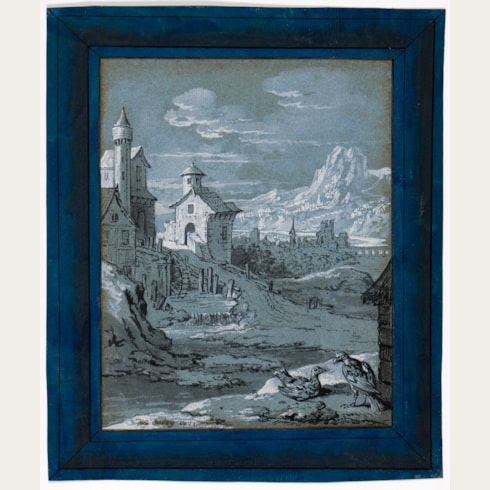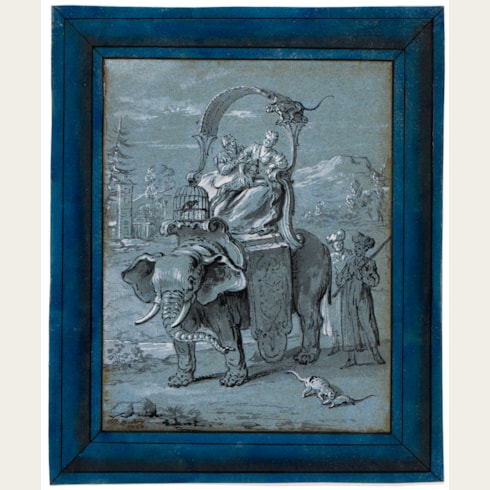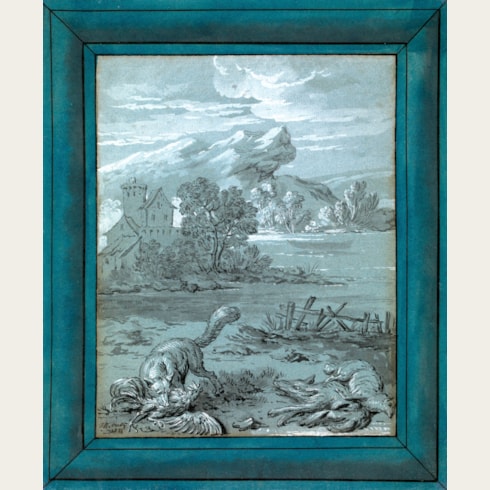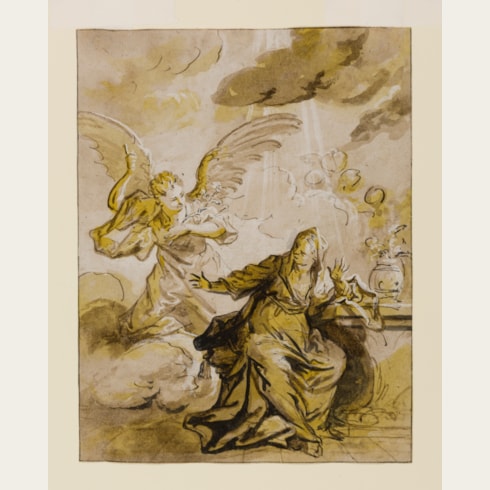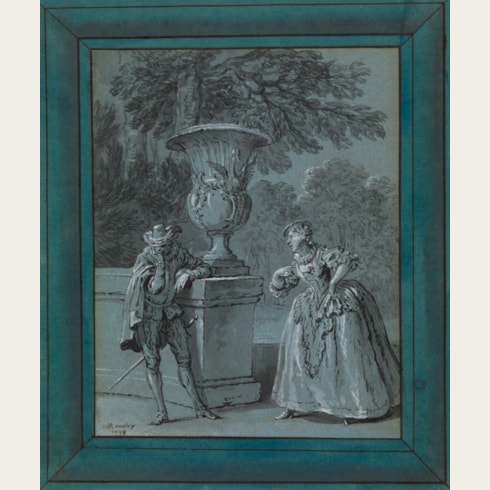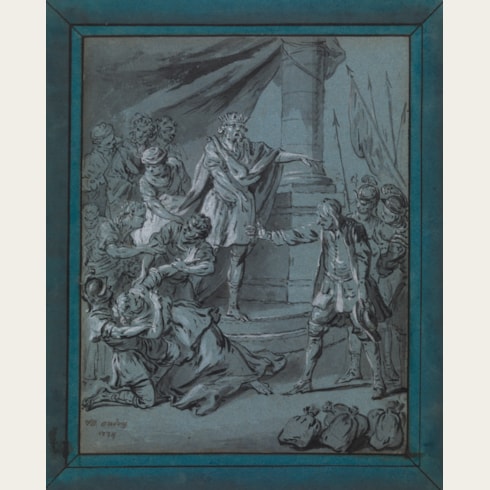Jean-Baptiste OUDRY
(Paris 1686 - Beauvais 1755)
Belphegor, A Tale by Machiavelli: Roderic and Matheo
Sold
Brush and black ink and grey wash, heightened with white, within a simulated mount drawn in dark blue and grey wash with pen and brown ink, on blue paper.
Signed and dated JB. Oudry / 1734 at the lower right.
Inscribed 134. tom.2 on the verso.
242 x 189 mm. (9 1/2 x 7 3/8 in.) [image]
313 x 259 mm. (11 7/8 x 10 1/4 in.) [with fictive mount]
The present sheet – the third in the sequence - continues the story of the demon Belphegor, as described by Hal Opperman: ‘Bankrupt, Roderic takes flight into the countryside, with his wife’s family and his creditors close behind. He manages to elude his pursuers long enough to convince Matheo, a farmer he encounters, to help him escape into hiding. Roderic's negotiations with Matheo are the subject of the third drawing. In fulfillment of the bargain they reach, the spirit of Belphegor quits the body of Roderic (who now disappears from the tale) and takes possession of three young women in succession. Each time, Matheo appears, exorcises the evil spirit (the compliant Belphegor), and receives substantial rewards from the fathers.Three times was the agreed-to limit. However, Belphegor’s ten-year assignment has not expired, and he opts to take refuge in the body of a fourth young woman - the daughter of the King of Naples - and bide the remainder of his term there.’
Oudry’s skill as a draughtsman is readily evident in many of the drawings for La Fontaine’s Fables, which display a very effective use of white heightening against the deep blue of the paper. Having remained in albums for over two hundred years, the drawings by Oudry for the Fableshave remained in remarkable condition.
‘Jean-Baptiste Oudry is one of the most prolific artists – and without question the most versatile – of the French eighteenth century. Once established he was also one of the most successful of his time.’ Such is the Oudry scholar Hal Opperman’s succinct description of the artist, who enjoyed a successful career of more than forty years. A pupil of Michel Serre and Nicolas de Largillière, Oudry took classes in drawing at both the Académie Royale and at the Académie de Saint-Luc of the Parisian painter’s guild, where he also later taught. The early part of his career found the artist painting mainly still life subjects and portraits. Admitted into the Académie Royale in 1719, by the following decade Oudry had come close to supplanting Alexandre-François Desportes as the leading painter of animals and hunting scenes. He began receiving significant royal commissions for paintings of hunts, and in 1725 was granted lodgings in the Tuileries palace. (The following year, at the request of Louis XV, he exhibited twenty-six of his paintings - the entire contents of his studio – in the Grands Appartements at Versailles.) It was also in 1726 that Oudry was engaged as a designer at the Royal tapestry works at Beauvais, where his masterpiece was the series of huge painted cartoons for the Chasses royales de Louis XV tapestries, eventually woven at the Gobelins, for which he was paid some 52,000 livres over a twelve-year period. In 1734 he was named director of the Beauvais factory, where he in turn soon employed the young François Boucher as a designer. The last fifteen years of his career saw Oudry paint numerous easel pictures of hunting scenes, dogs, game pieces and still life subjects, many of which were shown at the Salons. In 1743 he was appointed a professor at the Académie, where he had taught since 1739, although he does not seem to have been an inspirational teacher, and his only real pupil of any note was his son, Jacques-Charles Oudry. Apart from the King, Oudry counted among his most significant patrons the Swedish ambassador, Count Carl Gustaf Tessin, and the Duke of Mecklenburg-Schwerin.
Oudry was a prodigious draughtsman, and drawings were an integral part of his artistic practice. Although the 18th century art historian Antoine-Joseph Dezallier d’Argenville wrote of him that ‘His finished drawings are all in black chalk, highlighted with white using the brush [and] his studies are also in black chalk, highlighted with white chalk’, and while it is certainly true that black and white chalks were his favoured medium as a draughtsman, Oudry worked also in pastel, red chalk, brown ink and sepia wash. While the Oudry scholar Hal Opperman catalogued around a thousand drawings by the artist, many of these were only known through descriptions in old auction catalogues. While Oudry parted with some drawings in his lifetime, the vast majority of his output as a draughtsman – mainly studies of animals and birds, highly finished landscapes and book illustrations, carefully organized into albums - remained in his studio until his death.
Provenance
Sold by the artist, together with all of his drawings illustrating the Fables of La Fontaine, to Jean-Louis Regnard de Montenault, in c.1751
Included in one of two albums containing all of Oudry’s drawings for the Fables of La Fontaine, with the booksellers Jean-Jacques and Marie-Jacques de Bure (Frères de Bure), Paris, by 1828
Jean-Jacques de Bure, Paris
His sale, Paris, 1-18 December 1853, lot 344 (bt. Thibaudeau for 1,800 francs)
Comte Adolphe-Narcisse Thibaudeau, Paris
Possibly given by him to the actress Mme. Eugénie Doche, and then sold by her for 2,500 francs to the bookseller Auguste Fontaine, Paris
Acquired from them for 5,000 francs in 1856 by Solar Aaron Euryale, known as Félix Solar, Bordeaux
His sale, Paris, Charles Pillet, 19 November – 8 December 1860, lot 627 (sold for 6,100 francs to Cléder for Baron Taylor)
Baron Isidore Taylor, Paris
Émile Pereire, Paris
The booksellers Damascène Morgand and Charles Fatout (Morgand et Fatout), Paris, probably by 1876
Acquired from them for 30,000 francs by Louis Roederer, Reims, by 1877
By descent to his nephew, Léon Olry-Roederer, Reims and Paris
Sold through Thomas Agnew and Sons, London, to Dr. A. S. W. Rosenbach, Philadelphia, in 1922
The Rosenbach Company, Philadelphia
Acquired from them by Raphael Esmerian, New York, in c.1946
His sale, Paris, Palais Galliera [Ader Picard Tajan], 6 June 1973, part of lot 46 (two albums sold for 2,000,000 francs)
One album with Art Associates Partnership (Dr. Claus Virch), New York and Bermuda, by whom the album disbound and the drawings contained therein – including the present sheet – thence sold separately
Private collection, Geneva
Adrian Ward-Jackson, London
Kate de Rothschild, London, and Didier Aaron Inc., New York, in 1993
Private collection.
Literature
Louis Gougenot, ‘Jean-Baptiste Oudry’, Mémoires inédits sur les artistes français, 1854, Vol.II, pp.379-380; Baron Roger Portalis, Les dessinateurs d’illustrations au dix-huitième siècle, Paris, 1877, Vol.II, pp.483-489; JeanLocquin, ‘Catalogue raisonné de l’oeuvre de Jean-Baptiste Oudry, peintre du roi (1686–1755)’, Archives de l'art français, 1912, pp.152-173, nos.933-1209 (this drawing p.173, no.1207); Marquis de Girardin, ‘L’édition des fables dite d’Oudry de La Fontaine’, Bulletin du bibliophile et du bibliothécaire, 1913, pp.330-332; Roger Gaucheron, ‘La preparation et le lancement d’un livre de luxe au XVIIIesiècle. Les Fables de La Fontaine, dites d’Oudry’, Arts et métiers graphiques, December 1927, pp.77-82; Hal N. Opperman, Jean-Baptiste Oudry, Ph.D dissertation, University of Chicago, 1972 (pub. New York and London, 1977), Vol.II, p.710, no.D493; Horace Wood Brock, Martin P. Levy and Clifford S. Ackley, Splendor and Elegance: European Decorative Arts and Drawings from the Horace Wood Brock Collection, exhibition catalogue, Boston, 2009, p.156, no.107, illustrated p.109.
Exhibition
New York, The Pierpont Morgan Library, Fables from Aesop to Thurber, 1965 (as part of an album); New York, Paris and London, Kate de Rothschild and Didier Aaron at Didier Aaron, Inc., Master Drawings, 1993, part of no.15; Stanford University, Cantor Center for Visual Arts, Classic Taste: Drawings and Decorative Arts from the Collection of Horace Brock, March-May, 2000; Boston, Museum of Fine Arts, Splendor and Elegance: European Decorative Arts and Drawings from the Horace Wood Brock Collection, 2009, no.107.





